Among a host of literary prizes, the Norwegian Booksellers’ Prize, the Riverton Prize (Golden Revolver), the Glass Key for best crime novel in the Nordic countries, and the prestigious Martin Beck Award, have all been conferred on Jorn Lier Horst for his literary output.
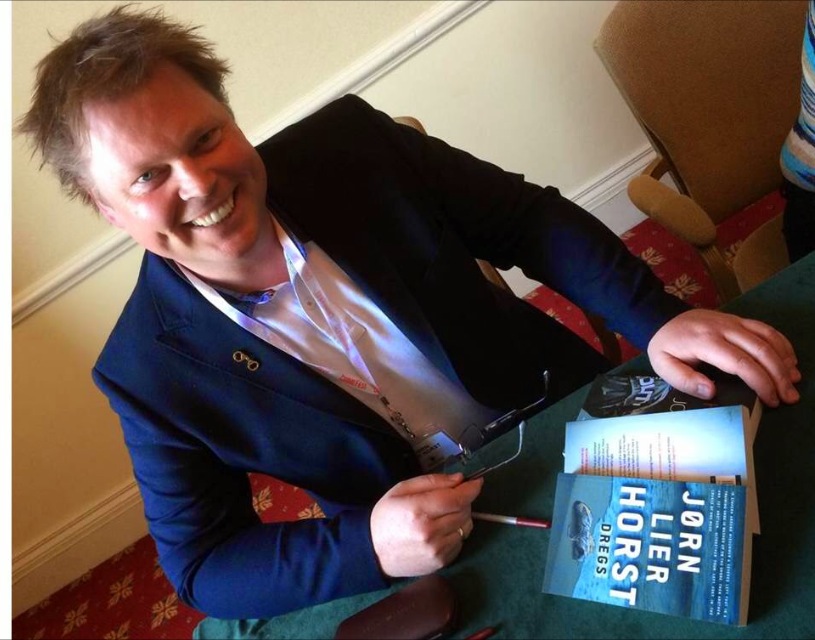
One person has rampaged through the crime literature of the past thirty years, more than anyone else. The serial killer. However, his – and statistics show that the serial killer is much more likely to be male - traces go much further back than you might think.
As for me, I belong to the group that prefers to give these psychopaths a wide berth, both as a reader and a writer, and I produced ten previous novels before deciding to set William Wisting on the pursuit of a serial killer. The groundwork for The Caveman became a fascinating journey into some of the sickest human psyches the world has ever known.
The actual concept of serial killing was first used in American police reports in the 1960s. At the beginning of the 1970s, the FBI introduced the term in cases where one perpetrator was responsible for more than two murders committed in various locations at different times.
Fiction
All the same, the trail of the serial killer takes us back several centuries in literary history. Probably William Shakespeare was one of the first writers to portray a serial killer when he penned Macbeth in 1606. After stabbing the King of Scots with a dagger, Macbeth was compelled to slay several of his guards to clear the way for him to take the throne. In order to retain power, Macbeth’s general Banquo, Lady Macduff and her son all in turn become victims of Macbeth’s thirst for blood.
Throughout the eighteenth and nineteenth centuries, serial killers crop up in a number of Gothic novels dealing with death, decay, madness, hereditary curses, evil forces and dark powers. The most famous is the story of Sweeney Todd, the Demon Barber of Fleet Street in 1847 – last seen in Tim Burton’s film reconstruction of 2007 with Johnny Depp as the vengeful Benjamin Barker.
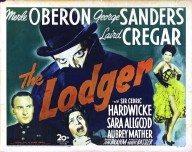 The novel The Lodger (1913) is considered to be the first actual crime novel to depict a serial killer. This story was written by Marie Belloc Lowndes, but most people are likely to be familiar with it from the Hitchcock dramatisation of 1926.
The novel The Lodger (1913) is considered to be the first actual crime novel to depict a serial killer. This story was written by Marie Belloc Lowndes, but most people are likely to be familiar with it from the Hitchcock dramatisation of 1926.
Agatha Christie herself tackled the subject in 1936 when she wrote about a serial killer who works his way through the alphabet (The A.B.C. Murders), and in 1929 Thomas Burke’s The Hands of Mr. Ottermole arrived on the scene and was later, in 1950, selected by Ellery Queen’s Mystery Magazine as the world’s best crime story.
The first Norwegian literary serial killer appeared in Trygve Hirsch’s novel Dødstonene (Death Music) of 1941. Paradoxically, it was the creators of the social-realism school of crime writing, the Swedish husband and wife team Sjöwall and Wahlöö, who made a serious effort to introduce the serial killer into Scandinavian crime literature. He makes an appearance as early as Roseanne, the first book in the Martin Beck series, in 1965. Since then, Henning Mankell has consolidated the serial killer’s position in several of his novels about Kurt Wallander.
The serial killer par excellence, however, is Hannibal Lecter. The brilliant psychiatrist, who from his prison cell both assists the police in their pursuit of new serial killers and communicates with his followers, has become one of the major icons of popular culture. He first turns up in Thomas Harris’s novel Red Dragon in 1981. He is most famous from The Silence of the Lambs which was filmed with Jodie Foster playing the role of a novice FBI agent and of course Anthony Hopkins as the cannibalistic serial killer.
Fascination
It is probably true that the identity of the writer with the honour of introducing the serial killer into literature will remain shrouded in mystery, just as anonymous as the serial killer with the nickname Jack the Ripper, who between the months of August and November 1888 allegedly murdered at least five female prostitutes in the East End of London.
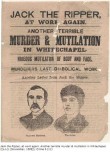 Jack the Ripper has featured in countless books and films since then. It is not difficult to see where Marie Belloc Lowndes drew inspiration for the aforementioned The Lodger, with a knife killer rampaging through the foggy streets of London.
Jack the Ripper has featured in countless books and films since then. It is not difficult to see where Marie Belloc Lowndes drew inspiration for the aforementioned The Lodger, with a knife killer rampaging through the foggy streets of London.
Jack the Ripper was the first serial killer in history to receive international media coverage, but the reason for his resonance in popular culture is probably that he was never caught or identified, despite a host of theories and hypotheses.
The story of Jack the Ripper cast such long shadows that he continues to inspire contemporary writers. The American crime novelist Patricia Cornwell published a book in 2002 in which the painter Walter Sickert was proposed as the serial killer. Since then, she has investigated the case together with a former Scotland Yard detective and spent a million dollars in an attempt to solve the mystery.
 Other real-life serial killers have also inspired authors. Both Norman Bates in Robert Bloch’s Psycho
Other real-life serial killers have also inspired authors. Both Norman Bates in Robert Bloch’s Psycho
and Hannibal Lecter are allegedly based on Ed Gein who murdered six people in the 1950s. In addition, he stole corpses from graves and used body-parts to create masks, clothes and furnishings. He also fashioned belts from human nipples and used skulls as soup bowls. In his house, items uncovered by police included four noses, nine masks made of human skin, a lampshade formed of skin from human faces, and nine pudendal lips in a shoebox.
It is easy to understand that it is simpler for a writer to use ingredients from real events rather than invent them. Factual incidents and characters lend credibility to the plot of a book and give it legitimacy. Such a tenuous dividing line between what has in fact happened and what might have happened, when novelists weave their way through the suspense-filled area between recognisable fiction and assumed reality, makes it less challenging to construct narratives in which readers can truly believe.
Facts
Ingenious serial killers have always played a game of cat and mouse with the police, but in the past thirty years they have become both crazier and more brutal. Serial killers in recent crime fiction seem to head in two different directions. On the one hand, we find the sexually-motivated serial killer who commits the most distasteful and bestial murders and collects trophies from his victims. A mastermind who leaves behind an obvious signature and communicates with the police via coded messages. The other direction can be said to be somewhat more straightforward. The murders are not committed from sheer lust, but are normally preceded by external escalating events which more or less force the perpetrator to make a clean sweep.
Serial killers certainly appear more often in literature than in reality. At Radford University, researchers have made an attempt at classifying our knowledge of real-life serial killers. The statistical data are quite telling: since 1960, there have been 1,982 serial killers in the USA. The total number of victims is 8,653. However, serial killers are responsible for around 2% of the 17,000 homicides per year in the USA. In the rest of the world, however, only 736 serial killers have been at work during the same period. Taking into consideration that the USA comprises only 5% of the global population, this type of crime can therefore be regarded as something of an American phenomenon.
Still, the statistics do not provide an unambiguous answer regarding what kind of person becomes a serial killer. Almost 60% of them, all the same, were bed-wetters until twelve years of age, but it is a myth that they are of extremely high intelligence. Nevertheless, there are common traits. Most are unmarried white men who have grown up with single mothers and had little or no contact with their fathers. The motive is usually related to emotions, and the vast majority are sexually orientated. Many are defined by forensic psychiatrists as psychopaths, that is they suffer from personality disorders, rather than being psychotic. Serial killers can therefore seem completely normal and often charming in everyday life.
There is usually no relationship between the perpetrator and his victim, though the victims are not randomly chosen. Serial killers frequently select victims with apparent similarities. The time that elapses between each murder can vary between hours, days, weeks, months or years. The method is normally the same each time, and that is what generally puts detectives on their trail.
Frightful
Serial killers elicit a ghastly fascination in most of us. These morbid stories about people who only feel alive when they kill, arouse our curiosity as few other occurrences do. Many of us are attracted to what cannot be explained, and for the majority of people, serial killers present an inexplicable phenomenon: their lack of empathy, absence of guilt, the idea that someone can experience lust and satisfaction through abducting, torturing, raping, maiming, and murdering, and yes, occasionally even eating the flesh of another human being, these are all features that most people find incomprehensible. And the serial killer personifies, as few others do, what we consider to be pure evil. The majority of us are fortunately spared this in our own lives; we are able to respond to it from a safe distance, in the form of novels, on the cinema screen, or in a TV series.
We are keen to know more about these patterns of behaviour, and our inquisitiveness as human beings is multi-faceted and complex. We are at one and the same time sensation-seeking and compassionate, we slow down and stare in the aftermath of a road accident, and it’s a rare person who remains seated on the sofa if a police car stops outside a neighbour’s house. We sit for hours watching the news channels when major disasters and natural catastrophes take place. And even as spectators, we can feel the quivering excitement as adrenalin courses through our bodies. We may feel a sense of guilt at the inappropriate satisfaction this gives us, but can’t really be blamed for that. Adrenalin has a powerful, euphoric and even addictive effect on us. Just ask a child who wants to spin on a roundabout until it makes him physically sick.
As entertainment, then, these stories contain a peculiar darkness and a special power to draw readers in and let us forget reality for a while. Or maybe not. Because at the back of the reader’s mind is the tantalising knowledge that a serial killer can be an apparently perfectly ordinary person, without any external indication of the evil that lies within. No matter how many victims they have on their conscience or how bestially they commit their crimes, they still wake every morning to their accustomed routines. They are monsters hidden in the commonplace, murderers who push shopping trolleys, frequent coffee bars, walk a dog in the park or as in The Caveman, they can even live behind a neighbour’s front door.
THREE OF THE WORST
1 Ed Gein
 Strictly speaking, Gein was only convicted of two homicides, but between 1954 and 1957 he killed and skinned six women.
Strictly speaking, Gein was only convicted of two homicides, but between 1954 and 1957 he killed and skinned six women.
He was obsessed with the idea of being a woman and started out as a grave robber. He stole fresh corpses and removed the skin from them, sewing it into a tightly fitting costume for him to wear. One of the graves he opened was that of his own mother.
Ed Gein died of heart failure in a mental hospital in 1984. His own grave, at Plainfield Cemetery, has been regularly vandalised. Numerous people have chipped off fragments of his gravestone to take home as souvenirs. In the year 2000, the gravestone itself was stolen, though it was later recovered and is now housed in a museum.
2 Ted Bundy
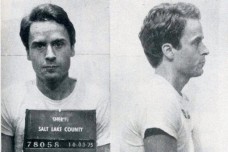 Ted Bundy was active throughout the USA between 1974 and 1978. After denying all charges for more than a decade, in 1987 he confessed to twenty-eight murders and a corresponding number of rapes. The actual total varies and some investigators believe he was responsible for at least thirty-six homicides. He was also found guilty of necrophilia and desecrating bodies.
Ted Bundy was active throughout the USA between 1974 and 1978. After denying all charges for more than a decade, in 1987 he confessed to twenty-eight murders and a corresponding number of rapes. The actual total varies and some investigators believe he was responsible for at least thirty-six homicides. He was also found guilty of necrophilia and desecrating bodies.
Bundy was intelligent, well-spoken and to all appearances, extremely charming. Inside, he was burdened with wild fantasies about violent sex, coercion and hunting down human beings. In his most active phase, he abducted, raped and killed one woman every month.
As early as 1975, he was suspected of the murder of a schoolgirl, but he fled from the trial. He was recaptured after one week on the run, but before he could be brought before the court again, he escaped from prison. He lived on, continuing to commit murders, under the name Chris Hagen, until he was finally re-arrested in February 1978.
On 24th January, 1989, he was executed in the electric chair at Florida State Prison.
3 Robert Pickton
 Pig farmer Robert Pickton from Vancouver was convicted of killing six women in 2007. He told an undercover police detective, who had infiltrated the jail disguised as an inmate, that during a period of twenty years starting in 1982 he had killed a total of forty-nine women, and that it had been his aim to kill fifty. In conversations in his cell, he also explained how he strangled his victims before taking them out into the pigsty. There, he strung them up on meat hooks, drained them of blood and removed their intestines. After that, he fed what was left of the corpses to the pigs. Following these revelations, the public health authorities issued a warning to neighbours who had bought pork from Pickton’s farm that the meat could be infected because of contamination with human remains.
Pig farmer Robert Pickton from Vancouver was convicted of killing six women in 2007. He told an undercover police detective, who had infiltrated the jail disguised as an inmate, that during a period of twenty years starting in 1982 he had killed a total of forty-nine women, and that it had been his aim to kill fifty. In conversations in his cell, he also explained how he strangled his victims before taking them out into the pigsty. There, he strung them up on meat hooks, drained them of blood and removed their intestines. After that, he fed what was left of the corpses to the pigs. Following these revelations, the public health authorities issued a warning to neighbours who had bought pork from Pickton’s farm that the meat could be infected because of contamination with human remains.
The police spent more than seventy million dollars on their examination of the pigsty and the rest of the farm, but they found sufficient forensic evidence to link Pickton to only six murders.
THREE OF THE BEST
1 The Silence of the Lambs by Thomas Harris
A psychopath is on the loose. He has already murdered five women and the press have nicknamed him ‘Buffalo Bill’. FBI-trainee Clarice is sent to interview the brilliant psychiatrist Dr. Hannibal Lecter, who has the best qualifications to assist her: he is himself under lock and key for having committed several bestial murders. However, Clarice has to pay a high price for the information. For every clue that Lecter gives her, she has to confide in him her innermost thoughts and deepest fears.
This is the second of the Hannibal Lecter books and both it and its predecessor, The Red Dragon, have been made into films – but The Silence of the Lambs certainly belongs on every crime fiction bookshelf.
2 The Killer Inside Me by Jim Thompson
Lou Ford is the sheriff of a small town in Texas. He has a friendly greeting for everyone, and is considered to be, in short, an all-round great guy. But at any moment, he can completely unravel. Deep inside, he is a heartless man who feels an urge and need to kill. One day he meets an attractive young prostitute and soon the impulse to kill gains the upper hand. The Killer Inside Me is a frightening journey into a dark country, with a crazy sheriffas travel guide. It, too, has been made intoa film.
3 The Bone Collector by Jeffery Deaver
Lincoln Rhyme was formerly in charge of NYPD’s Forensics Department. Following a gunshot wound he has been paralysed for a number of years, and now devotes his days to making elaborate plans for his own death. But then a macabre corpse turns up. The forensic evidence is sparse and most peculiar, and Rhyme is the only person who can interpret the clues to the killer. He is reluctantly persuaded, on a temporary basis, to postpone his plans for his own death, in order to assist his former colleagues in the investigation.
… and THREE WHO GOT AWAY
1 The Zodiac Killer
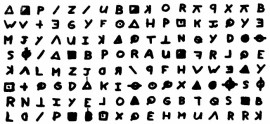 The Zodiac killer operated in California at the end of the 1960s and beginning of the 1970s. Through a series of taunting, coded letters sent to various newspaper editors in the San Francisco area, he claimed to have slain as many as thirty-seven people, although the police have only succeeded in linking him to five homicides and two attempted homicides. The letters were signed ‘Zodiac’. Several of them contained cryptograms, only one of which has been deciphered, and according to the killer himself, his true identity is concealed within the letters.
The Zodiac killer operated in California at the end of the 1960s and beginning of the 1970s. Through a series of taunting, coded letters sent to various newspaper editors in the San Francisco area, he claimed to have slain as many as thirty-seven people, although the police have only succeeded in linking him to five homicides and two attempted homicides. The letters were signed ‘Zodiac’. Several of them contained cryptograms, only one of which has been deciphered, and according to the killer himself, his true identity is concealed within the letters.
2 The Doodler
 The Doodler approached his victims in nightclubs and bars for gay men in San Francisco during the 1970s. He acquired his nickname because he often used pen and paper to draw doodles while meeting his victims.
The Doodler approached his victims in nightclubs and bars for gay men in San Francisco during the 1970s. He acquired his nickname because he often used pen and paper to draw doodles while meeting his victims.
A total of fourteen men were murdered by The Doodler, while another three survived. Being homosexual in the USA of the 1970s was still regarded as shameful, and none of the survivors would come out of the closet in open court. One of them was reputedly well known in show business, and another had diplomatic status. The police interviewed a suspect, but he never admitted responsibility for the numerous killings. The name of the suspect has never been revealed and the case has still not been solved.
3 Cleveland’s Mad Butcher
The Mad Butcher of Kingsbury Run, aka the Cleveland Torso Murderer, was a serial killer who murdered and dismembered at least twelve people in the 1930s. He targeted poor, homeless drifters, and some investigators believe that there may be as many as forty victims in his series of slayings. The victims were of both sexes, and the cause of death in many instances was the actual dismemberment. The men were usually also found to have been castrated. Not all of the victims were identified, because their heads were not found.
In an attempt to discover a connection between the victims and the killer, the investigators had plaster casts made of some of the victims. The death masks were put on display, some with the actual victim’s hair attached, and thousands of people flocked to see them. Two of the victims were identified, but the majority remain anonymous – just like the killer himself.
Photo Jorn Lier Horst copyright: Ali Karim 2013
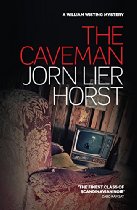
The Cavemman released 19 Feb, 2015. Sandstone Press. Pbk £8.99
Buy your copy here
Read our review here
spyware apps for android
link cell spy monitoring software
I cheated on my husband
site wives who cheat
celecoxib pill
open temovate 0.05%
free printable viagra coupons
open free discount prescription card
discount prescription drug card
read free discount prescription cards
bystolic coupon mckesson
forest laboratories patient assistance
cialis savings and coupons
link free cialis coupon 2016
naprosyn 750 mg
click naprosyn jel nedir
pletal y cirugia
peider.dk pletal 100 mg precio
how many abortions can a woman have
abortion center abortion clinic in atlanta
dexamethasone suppression test
web-dev.dk dexamethasone mechanism of action in cancer
revia reviews
open naltrexone alternatives
naltrexone how long does it last
click ldn colitis